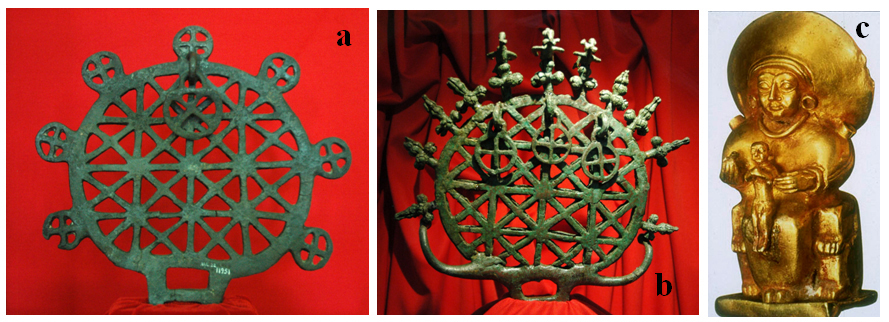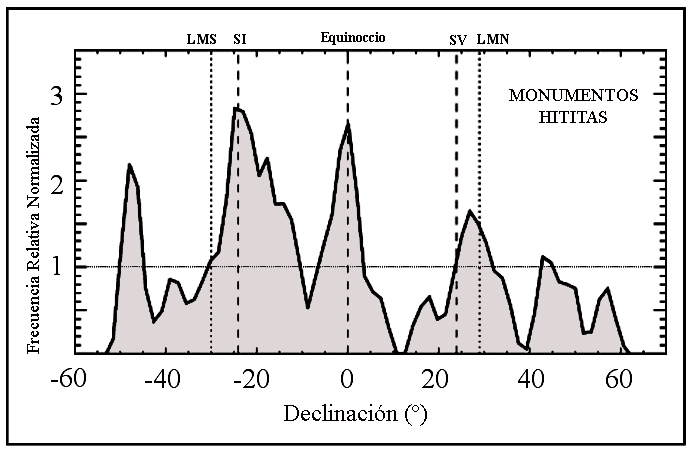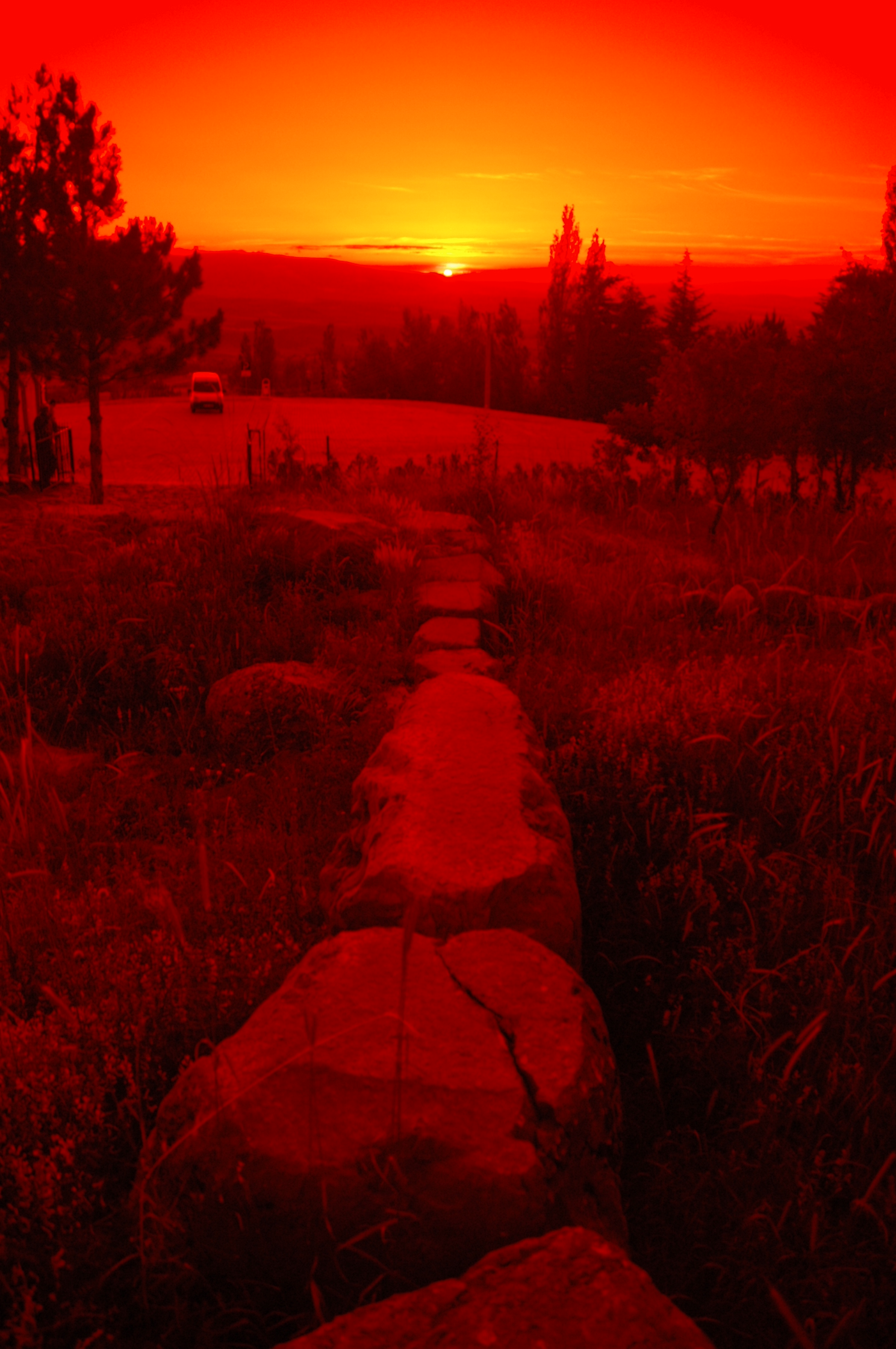Astronomy and landscape in the Hittite lands (see here and below)
Astronomía y paisaje en las tierras hititas
Simbolismo astral en el mundo hitita (© M. Sanz de Lara)

Astral symbolism in the Hittite world (© M. Sanz de Lara)
Dentro del marco de nuestro proyecto se ha estudiado el contexto geográfico, histórico y antropológico de un posible interés en el cielo por parte de los antiguos hititas. Especial atención se ha dedicado a analizar la antigua religión hitita dentro de su contexto en Anatolia, en particular los cultos solares y el calendario festivo. Contemporánea con el Reino Nuevo en Egipto, los habitantes del Imperio Hitita y sus señores, los reyes del País de Hatti, produjeron una sociedad muy sofisticada, heredera de una larga tradición cultural en Anatolia de varios milenios de antigüedad. Sin embargo, los estudios de astronomía cultural en esta área y este período determinado han sido prácticamente inexistentes aunque análisis preliminares de algunos monumentos hititas, como Yazilikaya, y de algunas fuentes escritas han demostrado cierta evidencia sobre un posible interés en el cielo. Se ha hecho una revisión de la antigua religión hitita buscando aquellos aspectos del culto que podrían ser de interés para nuestro trabajo. Estos han sido las divinidades solares y astrales, el espacio sagrado y sus administradores, los sacerdotes, el calendario de fiestas y, por último, el culto a los muertos y los espacios relacionados y su topografía. Ésta es la primera visión seria dedicada a estudios de astronomía cultural de la civilización hitita. En este sentido, hemos analizado en profundidad las fuentes bibliográficas, incluyendo algunos textos originales, haciendo claramente hincapié en la importancia de los cultos solares. También se han establecido ciertas sugerencias en el uso sagrado del tiempo por parte de los hititas con un cierto grado de certeza. Esto ha sido útil para una comparación final con los datos proporcionados por la investigación arqueoastronómica.
Como una consecuencia lógica del estudio de la orientación de los templos en la cuenca mediterránea (que es la base de nuestro proyecto), y especialmente de los templos del antiguo Egipto, se decidió ue los monumentos hititas de la Edad del Bronce serían un excelente laboratorio de pruebas para ampliar el análisis de posibles orientaciones astronómicas o topográficas (o ambos a la vez) en la cuenca editerránea. Esto sería pertinente no sólo para la comparación con otras culturas vecinas y contemporáneas sino también con el fin de obtener algunos conocimientos sobre una región tan importante del Medio Oriente como la península de Anatolia. Se ha demostrado que el análisis de una muestra estadísticamente significativa de templos hititas indica que los antiguos monumentos ititas no estaban orientados aleatoriamente como se había argumentado anteriormente. Por el contrario, hubo patrones bien definidos de orientación que podrían interpretarse en el contexto de la religión y la cultura hitita. Este es el primer trabajo de campo intensivo dedicado a los estudios arqueoastronómicos de la civilización hitita. Se ha podido obtener datos de casi un centenar de estructuras sagradas erigidas por las antiguas civilizaciones de Anatolia, como los hititas y los frigios como resultado de una campaña de trabajo de campo intensiva. El análisis de los datos ha demostrado ser muy fructífero y permite lograr excelentes resultados. Por ejemplo, los datos confirman la evidencia textual y han demostrado la importancia de la orientación solsticial y "equinoccial" (ver figura) que podría explicarse en el contexto de las necesidades del culto solar de los antiguos hititas. De hecho, Hattusa, su capital, ha mostrado un paisaje astronómico y topográfico llamativo y muy interesante, donde se ha ilustrado relaciones potenciales entre fenómenos astronómicos y diferentes elementos del paisaje local. Todo esto se refleja en le artículo publicado en un Journal for the History of Astronomy (2011, 42, 461), donde nuestra intención ha sido poner la arqueoastronomía en lugar que se merece dentro de los estudios hitotológicos.
Histograma de declinación de los monumentos hititas. Se destacan los dos picos, solsticial y equinoccial (© J.A. belmonte y C. González)

Declination histogram of Hittite monuments, notice the peaks at solstitial and equinoctial
declinations (© J.A. Belmonte & C. González)
Within the framework of our project the geographical, historical and anthropological context of a possible interest on the heavens by the ancient Hittites has been scrutinized. Special care has been devoted to analysing ancient Hittite religion within its Anatolian context, notably the solar cults and the festival calendar. Contemporaneous with the Egyptian New Kingdom, the inhabitants of the Hittite Empire and their masters, the Kings of the Land of Hatti, produced a most sophisticated society, heir to a long Anatolian cultural tradition lasting several millennia. However, to our knowledge, cultural astronomy studies in this area and particular period have been practically non-existent although preliminary analyses of some Hittite monuments, such as Yazilikaya, and of a few written sources had shown certain clues to a possible interest in the sky. We have made a review on ancient Hittite religion looking for those aspects of the cult that could be of interest to our work. These have been the solar, and other astral, divinities, the sacred space and its administrators, the calendar of festivals -i.e. Hittite sacred time- and, finally, the dead cult and related spaces and topography. To our knowledge, this is the first serious insight dedicated to cultural astronomy studies of the Hittite civilization. In this respect, we have analysed in depth the bibliographical sources, including some original texts. The importance of solar cults has been clearly emphasized and certain hints on the ancient Hittite sacred time have been established with a certain degree of certitude. This has been useful for a late comparison with the data provided by the archaeoastronomical research.
As a logical consequence of the study of temple orientation in the Mediterranean basin -which is at the basis of our project-, and specially of the temples of ancient Egypt, it was decided that the Hittite monuments of the Bronze Age would be an excellent laboratory to further extend the analysis of possible astronomical or topographical orientations -or both- in the Mediterranean basin. This would be relevant not only for comparison with other neighbouring and contemporary cultures but also to get some insight into such an important region of the Middle East as the Anatolian Peninsula. We have shown that the analysis of a statistically significant sample of Hittite temples -and a few monumental gates- demonstrates that ancient Hittite monuments were not randomly orientated as previously argued. On the contrary, there were well defined patterns of orientation that could be interpreted within the context of Hittite culture and religion. This is the first intensive fieldwork dedicated to archaeo-astronomical studies of the Hittite culture. We have been able to obtain data for nearly a hundred sacred structures erected by ancient Anatolian civilizations such as the Hittite and the Phrygians as a result of a field prospective campaign. The analysis of the Hittite data has proven extremely fruitful and permits us to achieve excellent results. For example, our data confirm the textual evidence and have shown the relevance of solstitial and “equinoctial” (see figure) orientations that could be explained within the context of ancient Hittite solar cult necessities. Indeed, Hattusha has shown a striking and highly interesting astronomical and topographical landscape, where potential relationships between astronomical phenomena, built structures such as temples and monumental gates, and different elements of the local landscape have been illustrated. All these is reflected in our paper published in the Journal for the History of Astronomy (2011, 42, 461), where our intention has been to put archaeoastronomy on the correct footing it deserves within Hittitological studies.
Puesta de sol en el solsticio de verano en el eje de la puerta monumental de acceso al santuario de Yazilikaya, cerca de Hattusa (© J.A. Belmonte).
Sunset at the summer solstice in the axis of the monumental gate of the sanctuary of Yazilikaya, close to Hattusha (© J.A. Belmonte)
